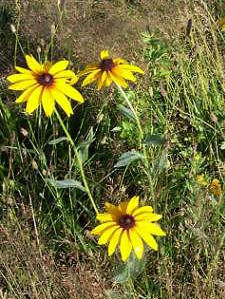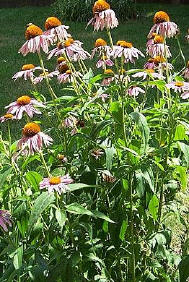Kay Hinkle
Adams County Master Gardener
 How many growing seasons have been just perfect for planting these last few years? How often have you been able to accurately predict the last frost of the season, allowing you to
plant immediately without worry of a freeze? And then there are the droughts - have they impacted the beauty (or survival) of your gardens these last few summers?
How many growing seasons have been just perfect for planting these last few years? How often have you been able to accurately predict the last frost of the season, allowing you to
plant immediately without worry of a freeze? And then there are the droughts - have they impacted the beauty (or survival) of your gardens these last few summers?
The good news is that these changing weather patterns have resulted in a more creative, adaptable group of gardeners in South Central Pennsylvania. We have learned that we can keep our plants hydrated by catching water that might have formerly been
wasted and that there are some pretty resilient, drought-tolerant plants. And in recent weeks, we have seen how high winds and thunderstorms can flatten a beautifully blooming garden at its peak!
We hear quite a bit about the jet stream - "a high-speed, wandering wind current (at least 57 mph) in the upper atmosphere that blows from west to east and affects weather". At an altitude of about 20,000 feet (6-9 miles) above earth's surface, the
jet stream is at the top of the earth's troposphere where most weather occurs. The core of the jet stream reaches an average windspeed of about 92 mph and can reach 300 mph in winter. These winds are stronger in the winter because the surface temperature contrasts are
greater.
Although the jet stream may stretch for thousands of miles around the world, it is only a few hundred miles wide and often less than 3 miles thick. This strong current of air pushes weather systems around the world, and greatly affects local weather
patterns by propelling them forward.
Especially interesting is the manner in which the jet stream affects weather worldwide. In the event of an eastward shift in warm Pacific water (known as an El NiZo), the atmosphere's
energy balance is changed. Warm ocean water supplies both moisture and energy for huge thunderstorms.
These thunderstorms feed both moisture and wind energy into the upper atmosphere, where they influence jet stream winds. When the warm water and thunderstorms move eastward, they help change the jet stream. These changes, in turn, move storms on
different paths than usual, upsetting normal patterns of wet and dry weather.
While the unusually cool, wet spring of 2003 served to delay the growing season, our plantings finally began to grow when the sun began to shine for extended periods of time. In contrast, a growing season with too little rain will have a significant,
negative impact on most plants.
In preparation for future drought conditions, it may make sense to incorporate a few plants that are adaptable to dry conditions. In our area, where drought conditions are cyclical in nature but inevitable, you may want to consider the following
plants that will flourish in dry conditions once they are established in your garden:
Perennials
- Asclepias tuberosa - Butterflyweed
- Artemisia spp. - Artemisia
- Aster spp. - Asters
- Baptisia australis - False blue indigo
- Centauria montana - Perennial bachelor's button
- Coreopsis spp.- Coreopsis
- Dianthus spp. - Pinks
- Echinacea purpurea -
Purple cone flower
- Echinops ritro - Globe thistle
- Erygium spp. - Sea holly
- Gaillardia spp. - Blanket flower
- Helleborus sp. - Hellebores
- Hemerocallis spp. - Daylily Hibiscus
- moscheutos - Common mallow
- Hosta sp. - Hosta
- Iris sibirica - Siberian iris
- Lavendula angustifolia
-Lavender
- Liatris spp. - Gay feather
- Nepeta spp. - Catmint
- Paeonia sp. - Peony
- Perovskia atriplicifolia - Russian sage
- Phlox spp.- Phlox
- Rudbeckia spp. - Black-eyed Susan
- Salvia spp. - Sage
- Sedum spp. - Sedum
- Sempervirens tectorum - Hens and chicks
- Stachys byzantina - Lambs
ears
- Stokesia laevis - Stokes aster
- Thymus spp. - Thyme
- Yucca spp. - Yucca
Annuals
- Calendula officinalis - Pot marigold
- Canna x generalis - Canna
- Capsicum spp. - Ornamental peppers
- Celosia cristata - Cockscomb
- Cleome - Spider plant
- Cosmos - Cosmos
- Digitalis purpurea - Foxglove
- Eschscholzia californica - California poppy
- Gazania rigens - Gazania
- Helianthus sp. - Sunflowers
- Helichrysum bracteatum - Strawflower
|

Butterflyweed
Asclepias Tuberosa

Black-eyed Susan
Rudbeckia hirta

Purple Cone Flower
Echinacea purpurea |
Hopefully, our summer plantings will enjoy a steady flow of moisture as needed this year. However, when selecting plants for next year's garden, you may want to be prepared for whatever the jet stream brings. If drought tolerance is a goal in your
garden, try planting a few selections from the list above. You can have constant color regardless in spite of what could turn out to be drought conditions here in South Central Pennsylvania.
Read other articles on gardening in drought conditions
Read other summer related gardening articles
Read other articles by Kay Hinkle